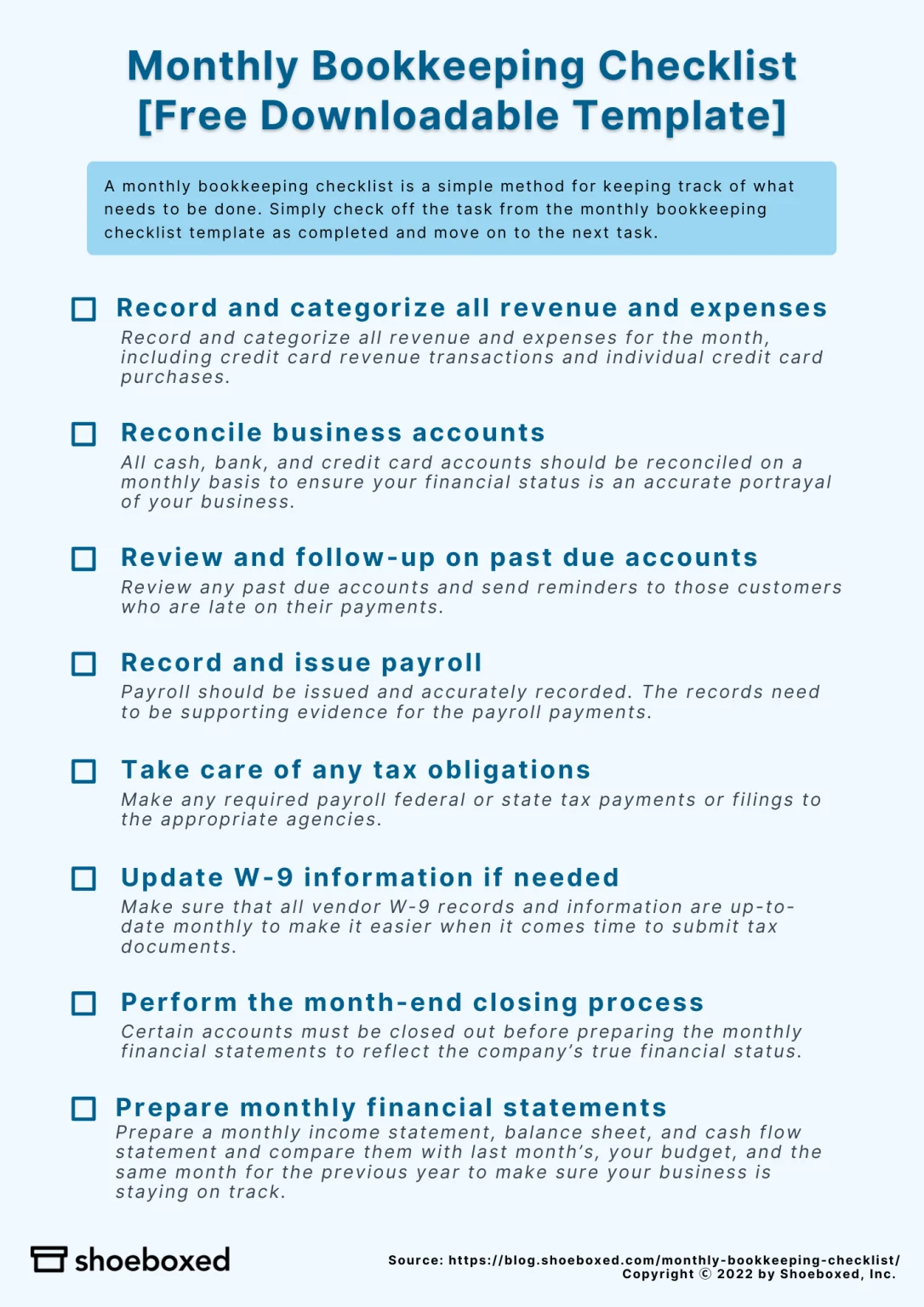Keeping your books up-to-date is essential if you want to run a successful business. Bookkeeping, on top of all of the other responsibilities that come with running a business, can feel very overwhelming to small business owners, especially when there are tasks that need to be completed on a daily, monthly, quarterly, and annual basis. Part of the struggle is knowing what needs to be done and when.
This is why having a bookkeeping checklist is so important. A monthly bookkeeping checklist is a great organizational tool that will keep your business on track and help ensure that all financial responsibilities are being met in a timely manner.

Monthly Bookkeeping Checklist [Free Downloadable Template]
What follows is a comprehensive bookkeeping monthly checklist of all of the accounting tasks that need to be completed. This is a simple method for keeping track of what needs to be done. Simply check off the task from the monthly bookkeeping checklist template as completed and move on to the next task. (Note: Use the free downloadable at the end of the article.)
You’ll be prepared for tax day when that time comes around.
1. Record and categorize all revenue and expenses
Record and categorize all monthly and annual revenue and expenses for the month so that you can keep up with the financial status of your business on a monthly basis. This includes credit card revenue transactions and individual credit card purchases.
This information will be used to generate the profit and loss statement and as supporting documents for your taxes or any audits that may come your way. Payments taken with credit cards count as business revenue, and qualified business expenses are tax deductible.
A Bookkeeper’s Best Friend ✨
Professional bookkeepers use Shoeboxed’s scanning service to scan receipts and stay on top of client accounts. Try free for 30 days!
Get Started Today2. Reconcile business accounts
All cash, bank, and credit card accounts should be reconciled on a monthly basis to ensure that your financial status is an accurate portrayal of your business. One important part of the process is to go back and look at the undeposited funds from the previous month to see if they cleared during the current month.
It’s also better to catch any accounting errors within the current month to prevent a snowball effect of errors from month to month. Also, transactions are more likely to still be fresh on your mind.
3. Review and follow-up on past-due accounts
It’s important to review any past due accounts and send reminders to those customers who are late on their payments. The sooner you can get a customer to pay their invoice, the more likely they are to pay.
It’s also important to hold a customer to their payment terms because this can have a big impact on your cash flow. This is also a good time to re-evaluate your collections process to see if it is effective or whether any changes need to be made.
Not only do you need to check to see if there are any customers who owe you, but you also need to make sure that you haven’t missed any payments to vendors that you owe.
4. Record and issue payroll
Paying your employees on time is extremely important. After all, they have financial obligations that need to be met as well. Payroll, if applicable, will need to be run at least once a month.
Not only should payroll be issued, but it also should be accurately recorded. The records need to be supporting evidence for the payroll payments.
5. Take care of any tax obligations
Be sure to make any required payroll, federal, or state tax payments or filings to the appropriate agencies. Also, annual, quarterly, and monthly sales tax returns must be filed with the state where your business is conducted.
6. Update W-9 information if needed
Make sure that all vendor W-9 records and information are up-to-date. Since contractors and employees come and go, if you keep all of their information updated on a monthly basis, then it will be so much easier when it comes time to submit tax documents.
7. Perform the month-end closing process
Certain accounts must be closed out before preparing the monthly financial statements to reflect the company’s true financial status. The temporary accounts need to be closed out so that the next period can start from zero.
Therefore, the month-end checklist should include (cash) journal entries for revenue accounts to be closed to the income summary account and expense accounts to be closed out to the income summary account. The Income summary then closes out to retained earnings and dividends closes out to retained earnings.
How To Create a Month End Close Checklist. Start With The Financial Statements Line Items! By The Financial Controller8. Prepare monthly financial statements
Prepare a monthly income statement, balance sheet, and cash flow statement. You should not only prepare these financial statements but also compare them with last month’s, your budget, and the same month for the previous year to make sure your business is staying on track. If not, it may be time to revise your budget and rethink your goal and business plan.
Free downloadable template: monthly bookkeeping checklist
Download the free downloadable PDF to help you keep track of your monthly bookkeeping tasks.
Free downloadable template: monthly bookkeeping checklist [PDF]
Free downloadable template: monthly bookkeeping checklist [PNG]
Stop doing manual data entry 🛑
Outsource receipt scanning to Shoeboxed’s scanning service and free up your time for good. Try free for 30 days! ✨
Get Started TodayFrequently asked questions
What’s in a monthly bookkeeping checklist?
A monthly bookkeeping checklist is a simple method for keeping track of what needs to be done. It includes recording revenue, categorizing expenses, reconciling accounts, addressing overdue payments, processing payroll, fulfilling tax obligations, updating W-9 information, completing month-end closing, and preparing financial statements.
In conclusion
A monthly bookkeeping checklist will save you time because it takes the guesswork out of what financial matters need to be addressed next. A checklist makes sure nothing falls through the cracks and keeps you organized and efficient so you can focus on other aspects of your business. It also ensures that you are meeting all of your financial responsibilities and tax deadlines. Missed deadlines can be a costly mistake resulting in some hefty fines and penalties.
Caryl Ramsey has years of experience assisting in different aspects of bookkeeping, taxes, and customer service. She uses a variety of accounting software for setting up client information, reconciling accounts, coding expenses, running financial reports, and preparing tax returns. She is also experienced in setting up corporations with the State Corporation Commission and the IRS.
About Shoeboxed!
Shoeboxed is a receipt scanning service with receipt management software that supports multiple methods for receipt capture: send, scan, upload, forward, and more!
You can stuff your receipts into one of our Magic Envelopes (prepaid postage within the US). Use our receipt tracker + receipt scanner app (iPhone, iPad and Android) to snap a picture while on the go. Auto-import receipts from Gmail. Or forward a receipt to your designated Shoeboxed email address.
Turn your receipts into data and deductibles with our expense reports that include IRS-accepted receipt images.
Join over 1 million businesses scanning & organizing receipts, creating expense reports and more—with Shoeboxed.
Try Shoeboxed today!



